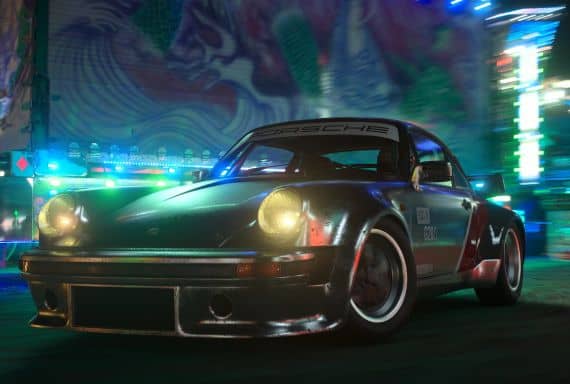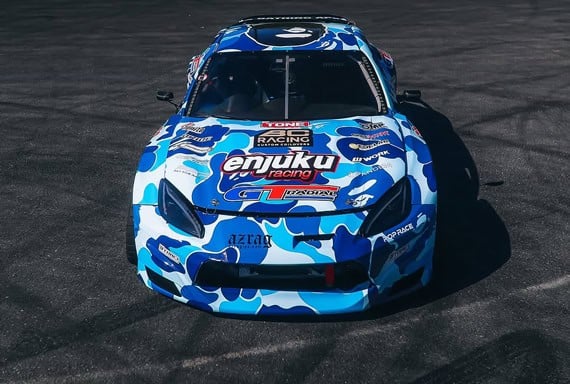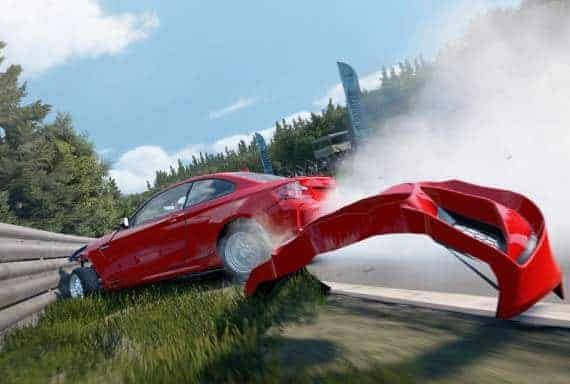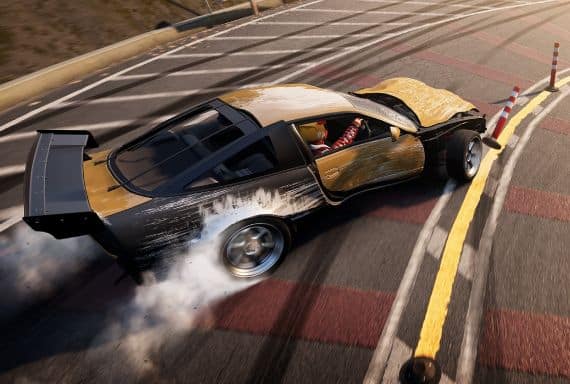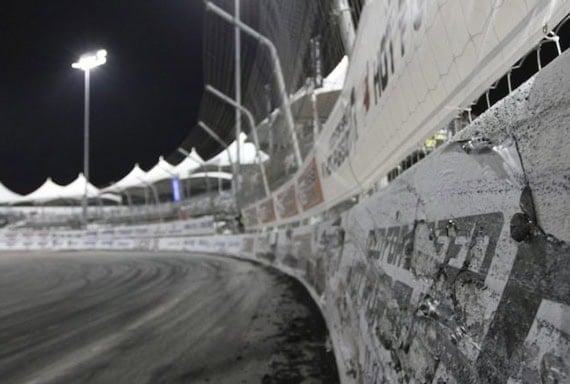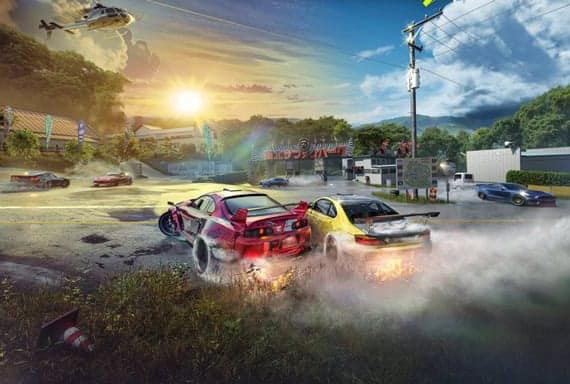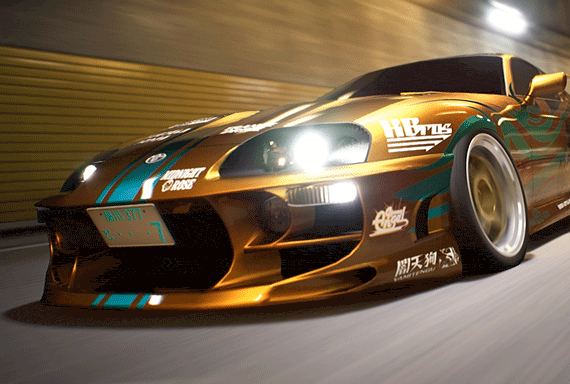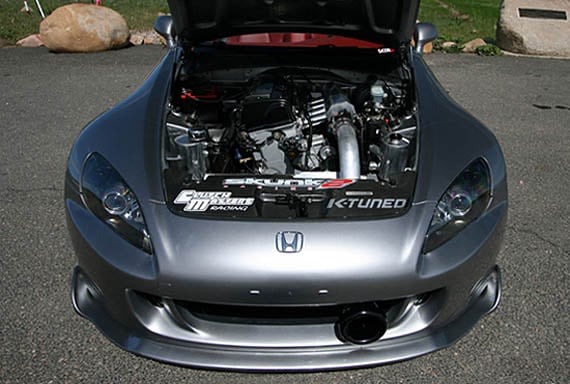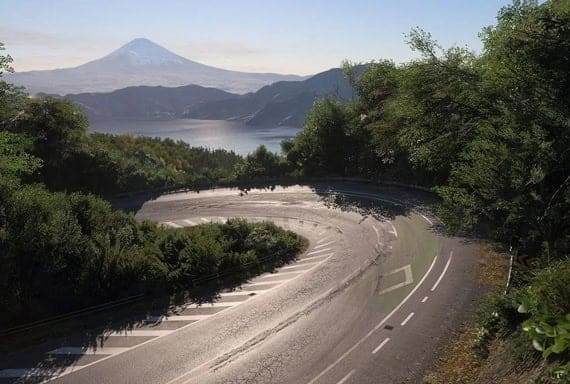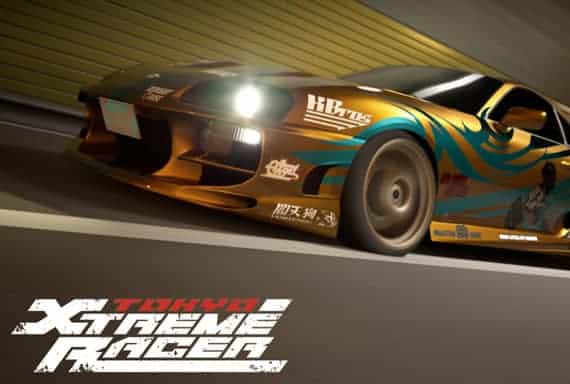Sim Racing vs. Sim Drifting Setups – What’s Different?
We explore the main differences between simulator drifting and racing setups to help with building your ideal virtual rig.

Jump To Section
Virtual motorsports have exploded in recent years, and games such as Assetto Corsa (AC) have completely revolutionized drifting games by providing almost every drift car, track, and mod you can imagine.
Not only are they immensely enjoyable, providing the closest experience you’ll get to the “real thing,” but they’re also incredibly realistic. So much so that 14-year-old drifting prodigy Hiroya Minowa, who has recently been causing an upset in the Formula Drift series, credits his insane ability to games such as AC.
In F1, the three-time World Champion Max Verstappen frequently has disagreements with his team for his long weekend sim-racing antics on iRacing.
While those at the top of the game are constantly using simulators to refine their skills, it also offers entry-level enthusiasts the chance to conveniently experience the low-risk enjoyment of drifting or racing at home. Plus, there’s no need to worry about trailers, overnight accommodation, fuel costs, car damage, and spare tires!
With that said as you can see in the video below, sim rigs can quickly get pretty expensive very quickly, too, so we’ll help you with the considerations that’ll ensure you make the right choices now rather than later.
With the ever-growing options available for sim racing and drift setups, it’s easy to feel overwhelmed when deciding which route to take. That’s why we’re breaking down how the two compare in the hope that we can help you find the perfect setup for your needs.
Sim racing and drifting share many common elements, but while racers focus on precision, consistency, and shaving milliseconds off lap times, drifters prioritize car control, angle, rapid transitions, and mastering the art of controlled chaos.
Let’s look at each aspect to help you decide what you need from your sim setup.
Choosing A Sim Rig/Cockpit
Firstly, a sturdy sim rig or cockpit is essential whether you plan to drift or race on your sim setup. These can range from a simple, sturdy table or a cheaper wheel stand for those on a budget to full-fledged racing rigs with a dedicated F1 seat or BRIDE bucket seats for drifters, along with specific mounting points for the additional accessories.
While racing is more about precise seating, especially for specific disciplines like F1, we typically like to go with a bucket seat for our drifting rigs to replicate the real thing. If you intend to get your own real-world car eventually, this can be a great opportunity to get the seat you intend to use when the time comes so that you’ve already had some (sort of) seat time.
When it comes to mounting, stability is a key factor, especially for drifting setups, which need to withstand aggressive transitions. Racing rigs will also require sturdiness, but you’re less likely to throw the wheel around at full rotation and push its limits to the same extent (unless you’re a particularly aggressive driver!).
Monitor(s) Or VR Headset?
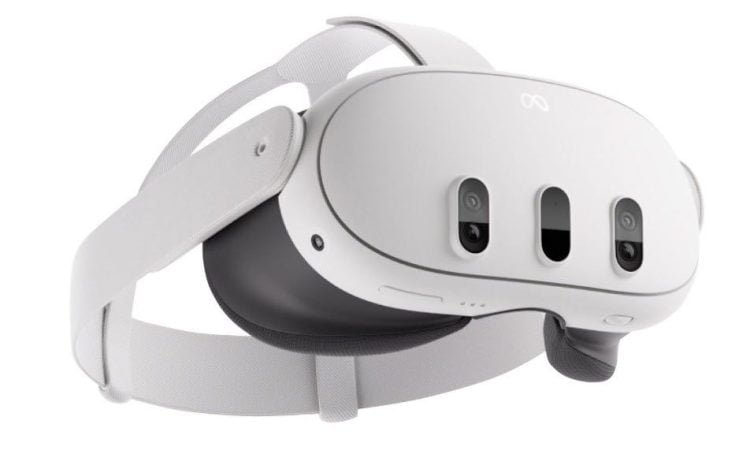
Whether you decide to go with one, two, or three monitors, or maybe you decide to go without a screen at all by instead opting for a VR headset, can change your sim rig considerations. While triple-monitor setups provide a great experience, you’ll need to count for the size, space, weight for mounting (likely requiring a premium rig), and cost.
VR headsets, on the other hand, mean you can completely do away with the screen, requiring much less space and not needing to worry about mounting. It also arguably delivers the ultimate sim drifting experience, allowing you to look out of your side windows, making it perfect for achieving the ultimate proximity in tandem battles.
Our VR racing games and headsets, article will explain everything you need to know if you’re considering going down this route.
Choosing Your Platform(s)
Before you dive into the specific components, you’ll want to decide which platform you’re most likely to play on. We highly recommend PC, as you’ll have the opportunity to appreciate the full extent of in-game mods in the likes of Assetto Corsa, which isn’t as easy on consoles.
Another downside of consoles is that some steering wheel setups are “locked” into a specific console. This means that if you decide to transition to PC gaming later, you’ll likely need to sell your setup and replace it with a compatible one. However, some are cross-compatible, which could be a consideration.
Steering Wheel/Base Considerations
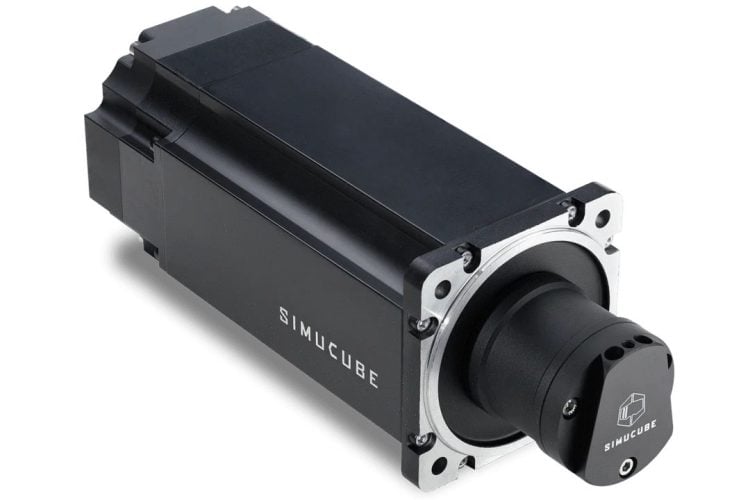
Choosing A Base
If you are considering a base and intend to alternate between drifting and racing frequently, we recommend looking at brands such as Moza, which provides a standardized quick-release system for simple wheel swapping. Other popular brands, such as Fantatec, require you to buy specific hubs or adapters for each wheel, and the genuine products aren’t cheap.
One of the main differences between choosing a racing or drifting base is the angle it can provide. While an F1 racing wheel setup would typically only need around 270 degrees for quick, precise inputs in high-speed racing scenarios, other motorsport disciplines may favor up to 540 degrees.
For drifting, the optimal angle is 900 degrees, allowing for realistic side-to-side transitions and optimal precision.
Direct-Drive
Direct-drive wheelbases are the premium choice for both drifting and racing. They offer the ultimate precision and realistic force feedback (FFB) and allow drivers to feel every aspect of the track and car behavior. This is particularly important in drifting, where you want to feel exactly what the tires are doing and how much traction you have with the surface.
Belt-Driven
Belt-driven wheels and bases are also excellent choices if a direct-drive setup is out of the budget. They offer strong, consistent FFB and a good balance of performance and affordability for serious racers. They also allow for fast rotation speeds, which is crucial for quick transitions when drifting and for fast input during racing.
Gear-Driven
If the options above are out of your price range, gear-driven wheels are often the choice for entry-level or budget sim setups. They can still provide a decent experience for beginners or casual racers. However, they won’t provide the same realistic feel or feedback, often feeling cheap and plasticky, and almost as though you can feel the gears doing their thing.
There’s also the consideration that drifting is particularly harsh on wheels due to the extremities, and it’s more likely to cause premature wear to the internal gears, which are often weak, particularly on the cheaper setups.
Opting For A Wheel/Pedals/Shifter Package
If you’re looking for a budget setup, a standalone wheelbase won’t need to be considered since these are typically an “all-in-one” package that combines the base, wheel, and pedals. Shifters are typically an optional upgrade.
Most of these will still allow you to swap out the wheel, but you’ll need to opt for an adapter to fit, and frequently swapping between drift/racing setups isn’t likely to be as convenient as the premium alternatives.
There are quite a few popular choices for an entry-level setup.
Something like the belt-driven Thrustmaster T300RS, which is currently $449 for the wheels and pedals, is a great entry-level setup that allows for cross-compatibility between PC and PS4.
Alternatively, a cheaper option is the gear-driven Logitech G923, which is currently $371.63 for the wheels, pedals, and shifter, making it a perfect entry-level setup. For cross-compatibility, you can choose between Playstation/PC and Xbox/PC. Admittedly, the T300RS is a slightly better wheel, as is the shifter, but it’s still a real bargain for the money.
Racing Steering Wheels
Keen sim racers might opt for a GT or a specific wheel on their sim rig, with numerous buttons for on-the-fly adjustments without taking their hands off the wheel, where feedback and precision are top priorities, as every millisecond counts when you’re hunting for that perfect lap time. However, this level of sophistication often comes with a hefty price tag, with some premium wheels costing as much as a decent used car at $2,499.
On the other hand, rallying enthusiasts, for example, might opt for a larger, more “normal” wheel, like those used in drifting with fewer buttons, but they may choose to integrate paddle shifters, which aren’t useful for drifting.
Drifting Steering Wheels
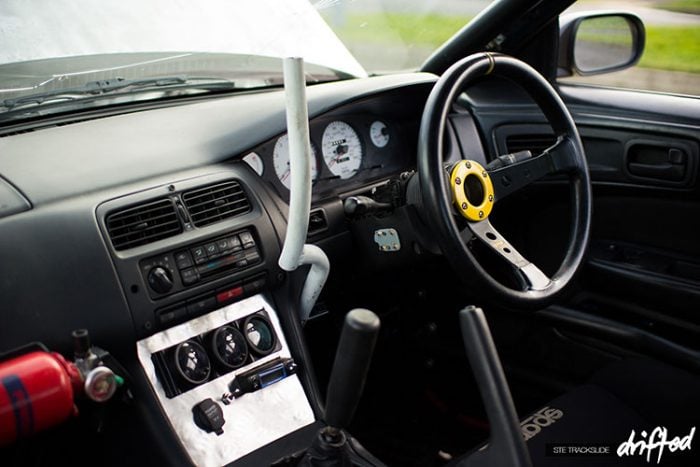
Drifters typically opt for smaller diameter, round, deep-dish wheels, typically around 270-320mm. The compact size allows for snappier input, essential for initiating a drift or transitioning between corners, as you might have seen in old-school Japanese videos. We typically opt for a genuine leather or Alcantara wheel, and choosing whether to go deep dish or flat typically comes down to the seating position of your setup.
Unlike racing wheels, buttons aren’t essential for drift wheels beyond what’s needed for navigating menus. We prefer to opt for a keyboard, as you’re much less likely to need to make rapid, on-the-fly changes like you would in a high-intensity F1 race.
Pedal Comparisons
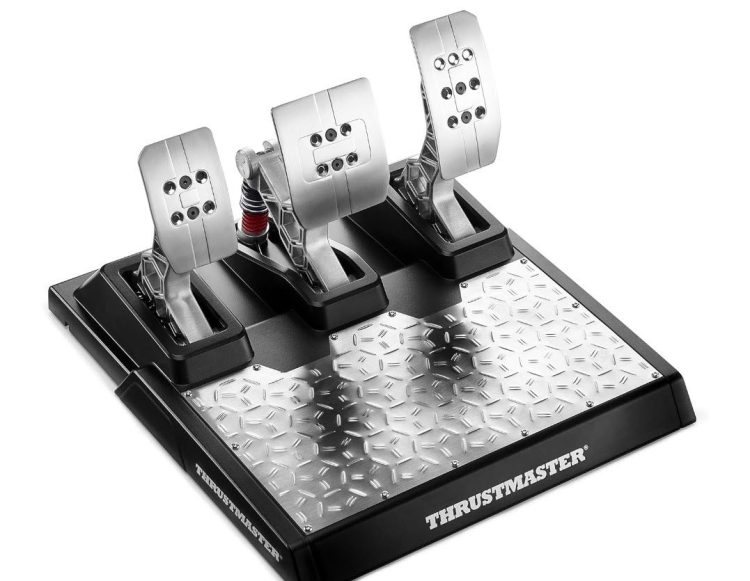
One of the main differences between a racing setup and a drifting setup is the clutch pedal. While some racing setups, such as F1, won’t require one, we feel the clutch is absolutely essential for drifting.
Those of you who want to do other racing, such as rally, on the other hand, may choose to go with your personal preference, but we always like to keep things as realistic as possible. I mean, that’s the whole point of a sim setup, right?
If you’re considering a Logitech setup, you could potentially upgrade to the Logitech G PRO Loadcell Pedals later. The Thrustmaster alternative would be the Thrustmaster T-LCM Loadcell Pedals.
Racing Pedals
For sim racing, pedals need to be highly responsive and precise, especially for braking and acceleration. Hydraulic pedals are considered the ultimate choice for racers, offering the most realistic braking feel. However, load cell pedals are also popular for their accuracy and consistency.
The potentiometer pedals found in cheaper setups will typically provide little resistance, feeling, or feedback, which can leave you guessing as to exactly what your feet are doing.
Drifting Pedals
Load cell pedals are typically the preferred and most common choice for drifting because they can precisely modulate brake and throttle inputs. Quick throttle response is crucial for drifting, and many prefer a stiff brake pedal with short travel to allow for quick stabs, which helps initiate a drift or adjust your angle.
While premium pedal setups are ideal, there are often adjustments that can be made for budget potentiometer pedals, such as placing some high-density sponge or firm rubber behind the pedals to add varied levels of resistance, which is usually lacking.
Shifter Comparisons
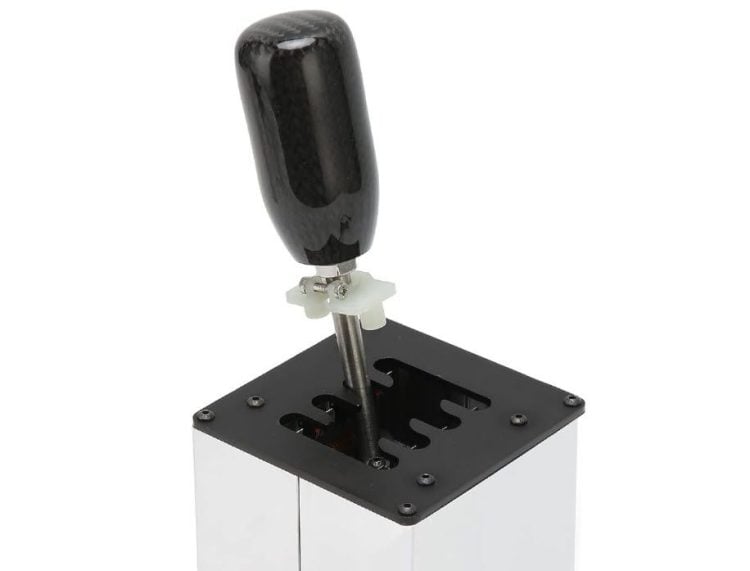
For racing, you’re more likely to want to prioritize speed and efficiency when it comes to shifting while drifting setups focus more on realism and convenience.
Racing Shifters
Paddle and sequential shifters are the most common choices in racing, mirroring real-world modern race car setups.
Paddle shifters, mounted on the steering wheel, allow for quick gear changes without taking your hands off the wheel, which is beneficial in high-speed racing scenarios.
Sequential shifters, while less common, are still used in some racing disciplines, and H-pattern shifters, which are even less common, are primarily used for vintage cars or street-style racing sims.
Drifting Shifters
Paddle shifters are also more of a hindrance than a help in drifting. The last thing you want is to try to find the correct flappy paddle while you’re doing rapid 900-degree transitions! If your wheel has them, it’s not a problem, but we don’t recommend using them for gear changes.
The choice between H-pattern and sequential shifters often depends on the type of drift car being simulated. H-pattern shifters are typically preferred for replicating affordable, entry-level drift cars, which could appeal to those looking to practice their real-world skills.
Sequential shifters, on the other hand, are less common and typically used to simulate high-end, professional-level drift cars. They offer quicker, more convenient shifting, but you’ll need to fork out big bucks if you intend to go for sequential in your real-world drift car.
E-Brake/Handbrake Comparisons
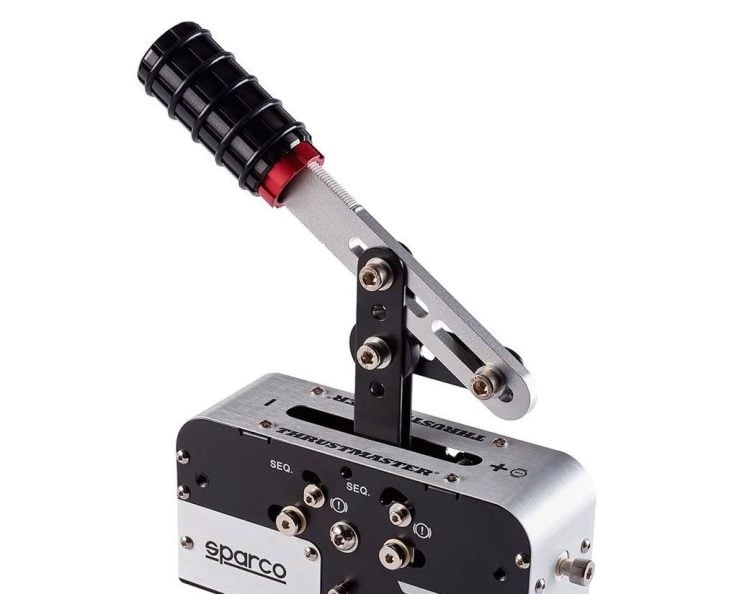
The handbrake serves different purposes and is of varying importance in sim setups. While it’s often convenient to have for some racing disciplines, we’d argue that it’s indispensable for sim drifting.
Racing E-Brake/Handbrake
Of course, you won’t need one of these for F1. They’re primarily used in rally racing simulators, where initiating with similar techniques to drifting, such as controlled slides or navigating tight hairpin turns, is crucial.
For circuit racing, precise brake pedal input is typically more important than the ability to use the handbrake, but it can potentially sometimes help in sudden emergencies.
Drifting E-Brake/Handbrake
In sim drifting, the handbrake (often called a hydro or e-brake) is considered essential for most. It helps with making quick angle adjustments, controlling the car’s rotation, and scrubbing off some speed where necessary. You’ll often see pro drifters frequently applying slight pulls to the hydro in precise tandem situations.
Drift setups almost always include a standalone USB handbrake that can be mounted separately from the wheelbase. Ideally, they should have a stiff, progressive feel to allow for precise control.
For budget-conscious sim drifters, a cheaper accessory such as a flight stick can be had for a few bucks and repurposed as a makeshift handbrake. Though it won’t provide the same level of realism as a premium product, we’ve successfully used these in the past, and they can be a great stop-gap while you’re saving after splashing out on the rest of the setup.
Budget vs. Premium Setups
We’re all too aware of just how much building the ideal sim rig can cost. Although it’ll set you back far less than real-world drifting, the initial payout can still be pretty eye-watering, depending on how extreme you want to go. This is especially true if you need to add a gaming PC or console to the equation.
Based on our past excessive expenditure, here are a few things we’d recommend considering:
Upgradability
Certain components are easier to upgrade later than others when building a sim setup. The wheelbase and pedals are often the most impactful upgrades, so investing in quality versions of these from the start can be beneficial.
Wheels, shifters, and e-brakes are generally easier to swap out or add later. To future-proof your initial setup, consider a wheelbase that offers compatibility with various wheels and peripherals, allowing for gradual upgrades as your skills and preferences evolve.
Longevity
Decent sim racing setups can range from entry-level options from the likes of Thrustmaster, which can be had for around $500, to professional-grade equipment from brands like Fanatec and SimuCube (over $6,500). Premium setups offer better performance, customization options, and durability, making them suitable for both racing and drifting enthusiasts looking for the ultimate experience.
Direct drive systems, while the most expensive, are much more likely to last longer due to their superior build quality and lack of wear-prone components like belts or gears. Unfortunately, this scenario is typically where “buy cheap, buy twice” (or three times, in some cases!) comes into play.
Key Differences
Premium setups, particularly direct drive systems, offer superior quality, force feedback, larger steering angles, and better materials, all of which help enhance the realism and precision of racing or drifting.
Budget setups can still provide an enjoyable and competitive experience. For example, a setup using something like a Thrustmaster TX Leather Edition with T3PA pedals, desk-mounted, combined with a shifter and a flight stick handbrake, can offer a solid starter setup for both.
Remember, the most important aspect is to make the most of what you have. A decent entry-level setup used skillfully can often outperform expensive equipment in the hands of a less experienced driver.
Our advice would be to get behind the wheel as soon as possible, start with what you can afford, and upgrade along the way as your skills and budget allow.
Buying Used vs. New
Used equipment can offer significant cost savings, allowing you to access higher-end gear at a fraction of the original price. However, it also comes with the risk of wear and tear, which may affect performance or long-term performance. The best-case scenario would be to buy from someone you know and trust who bought their setup on impulse and has hardly ever used it.
When buying used from someone you don’t know, make sure you thoroughly inspect the equipment and test all functions if possible.
Racing setups generally encounter less wear than drift setups. However, precision is crucial in racing, so ensure that any used gear, especially pedals and wheelbases, still provides accurate and consistent performance.
Drifting is generally harder on equipment due to its more aggressive nature and the rapid transitions involved, often putting serious stress on all of the components. Used drift setups might show more signs of wear, particularly on the wheelbase/wheel setup.
The best way to detect this is to ask for the opportunity to use it as you intend to. Chances are, especially with cheaper gear-based wheels that have been used extensively for drifting, it’s not going to perform as well as it did when it was new.
In both cases, while expensive, buying new ensures you get the latest technology and peace of mind with full warranty coverage, which can be particularly valuable for ensuring longevity. However, if budget is a concern, a carefully chosen used setup will often provide excellent value, especially for those just starting out in sim racing or drifting.






